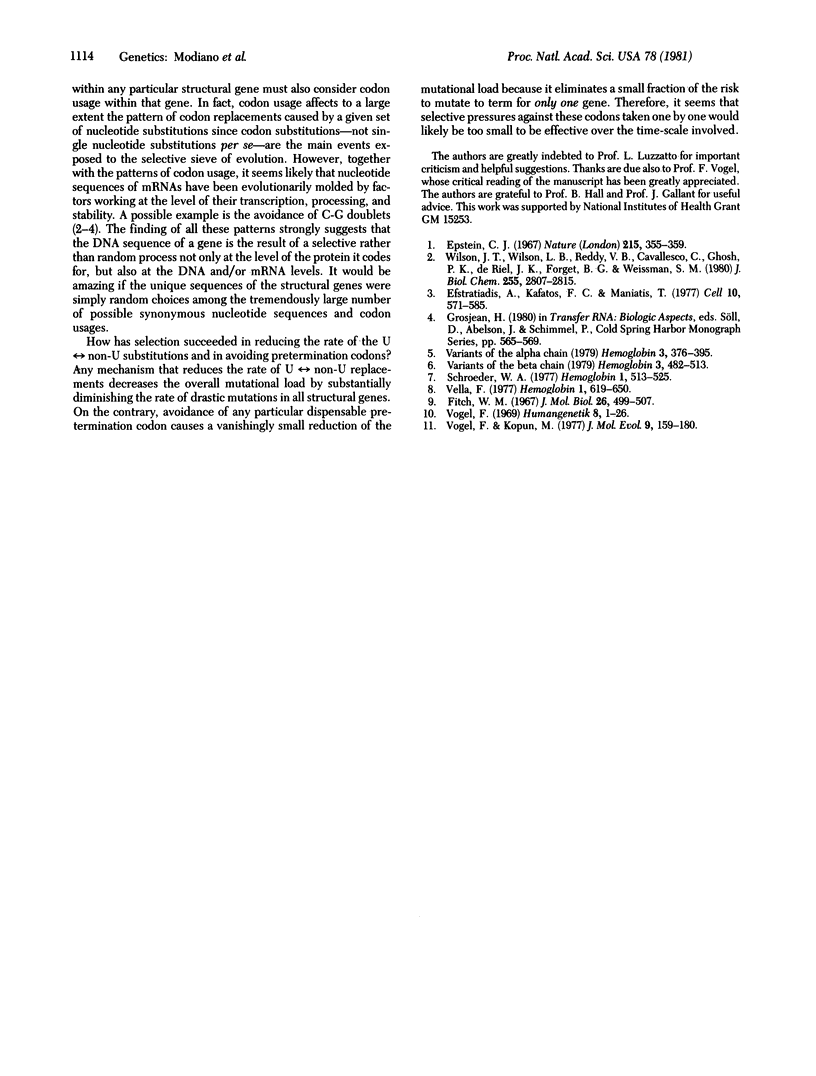Abstract
Nucleotide substitutions within a structural gene can cause two principal "drastic" phenotypic effects at the protein level: translatable leads to untranslatable and nonpolar hydrophobic in equilibrium hydrophilic amino acid substitutions. The sequence of nucleotides in the structural human alpha- and beta-globin genes and their variants were examined to determine whether codon usage, patterns of nucleotide substitutions, or both, reduced the relative and absolute rates of these unfavorable mutations. Based on translation of abnormal hemoglobins, it is likely that all 61 nontermination codons are potentially translatable, though only 47 are normally used. Moreover, codons that can mutate to a termination codon are never used whenever the corresponding amino acid is specified also by triplets that cannot mutate to termination by a single-step mutation. Thus, the number of opportunities to mutate to an untranslatable codon is reduced to the minimum compatible with the amino acid composition of these chains. The relative rates of U in equilibrium non-U substitutions were much lower than those of other substitutions. Because U residues must be involved in most termination mutations and in all nonpolar hydrophobic in equilibrium hydrophilic amino acid substitutions, there is a considerable reduction of mutational events, causing drastic phenotypic effects. These findings are likely to be the end result of evolutionary selection by yet unknown mechanisms.
Full text
PDF




Selected References
These references are in PubMed. This may not be the complete list of references from this article.
- Efstratiadis A., Kafatos F. C., Maniatis T. The primary structure of rabbit beta-globin mRNA as determined from cloned DNA. Cell. 1977 Apr;10(4):571–585. doi: 10.1016/0092-8674(77)90090-3. [DOI] [PubMed] [Google Scholar]
- Epstein C. J. Non-randomness of amino-acid changes in the evolution of homologous proteins. Nature. 1967 Jul 22;215(5099):355–359. doi: 10.1038/215355a0. [DOI] [PubMed] [Google Scholar]
- Fitch W. M. Evidence suggesting a non-random character to nucleotide replacements in naturally occurring mutations. J Mol Biol. 1967 Jun 28;26(3):499–507. doi: 10.1016/0022-2836(67)90317-8. [DOI] [PubMed] [Google Scholar]
- Schroeder W. A. The human gamma-chain variants. A review. Hemoglobin. 1977;1(6):513–525. doi: 10.3109/03630267709003416. [DOI] [PubMed] [Google Scholar]
- Vella F. Variation in hemoglobin A2. Hemoglobin. 1977;1(7):619–650. doi: 10.3109/03630267708999171. [DOI] [PubMed] [Google Scholar]
- Vogel F., Kopun M. Higher frequencies of transitions among point mutations. J Mol Evol. 1977 Apr 29;9(2):159–180. doi: 10.1007/BF01732746. [DOI] [PubMed] [Google Scholar]
- Vogel F. Point mutations and human hemoglobin variants. Humangenetik. 1969;8(1):1–26. doi: 10.1007/BF00286751. [DOI] [PubMed] [Google Scholar]
- Wilson J. T., Wilson L. B., Reddy V. B., Cavallesco C., Ghosh P. K., deRiel J. K., Forget B. G., Weissman S. M. Nucleotide sequence of the coding portion of human alpha globin messenger RNA. J Biol Chem. 1980 Apr 10;255(7):2807–2815. [PubMed] [Google Scholar]


